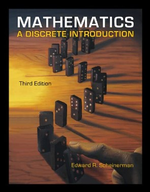Let G be with V .G/ D X [ Y where X D fx1; x2; x3g and Y D fy1; y2; y3; y4; y5g. example
Chapter 48, Problem 48.8(choose chapter or problem)
Let G be with V .G/ D X [ Y where X D fx1; x2; x3g and Y D fy1; y2; y3; y4; y5g. example of a complete bipartite graph. This particular complete bipartite graph is denoted K3;5. This concept is formally introduced in Definition 52.10. Every vertex in X is adjacent to every vertex in Y , but there are no other edges in G. Please do: a. Find all the maximal independent sets of G. b. Find all the maximum independent sets of G. c. Find all the maximal cliques of G. d. Find all the maximum cliques of G.
Unfortunately, we don't have that question answered yet. But you can get it answered in just 5 hours by Logging in or Becoming a subscriber.
Becoming a subscriber
Or look for another answer
